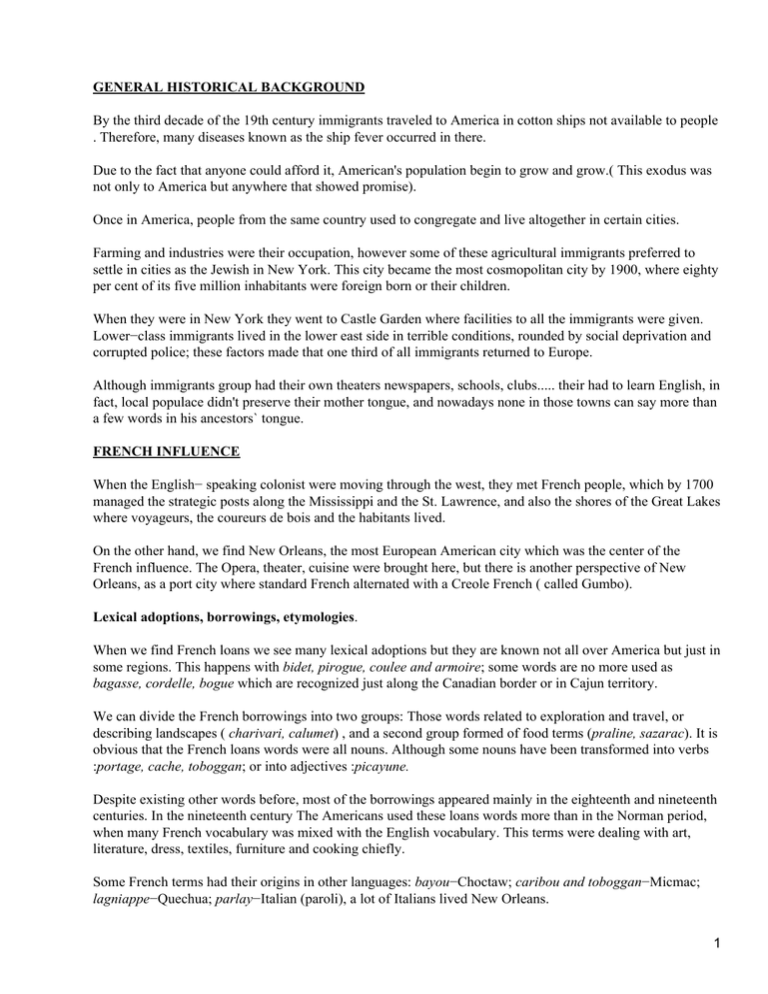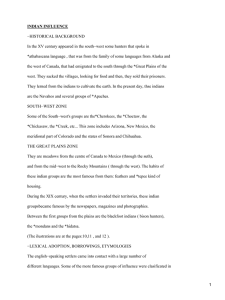American English: General Historical Background
Anuncio

GENERAL HISTORICAL BACKGROUND By the third decade of the 19th century immigrants traveled to America in cotton ships not available to people . Therefore, many diseases known as the ship fever occurred in there. Due to the fact that anyone could afford it, American's population begin to grow and grow.( This exodus was not only to America but anywhere that showed promise). Once in America, people from the same country used to congregate and live altogether in certain cities. Farming and industries were their occupation, however some of these agricultural immigrants preferred to settle in cities as the Jewish in New York. This city became the most cosmopolitan city by 1900, where eighty per cent of its five million inhabitants were foreign born or their children. When they were in New York they went to Castle Garden where facilities to all the immigrants were given. Lower−class immigrants lived in the lower east side in terrible conditions, rounded by social deprivation and corrupted police; these factors made that one third of all immigrants returned to Europe. Although immigrants group had their own theaters newspapers, schools, clubs..... their had to learn English, in fact, local populace didn't preserve their mother tongue, and nowadays none in those towns can say more than a few words in his ancestors` tongue. FRENCH INFLUENCE When the English− speaking colonist were moving through the west, they met French people, which by 1700 managed the strategic posts along the Mississippi and the St. Lawrence, and also the shores of the Great Lakes where voyageurs, the coureurs de bois and the habitants lived. On the other hand, we find New Orleans, the most European American city which was the center of the French influence. The Opera, theater, cuisine were brought here, but there is another perspective of New Orleans, as a port city where standard French alternated with a Creole French ( called Gumbo). Lexical adoptions, borrowings, etymologies. When we find French loans we see many lexical adoptions but they are known not all over America but just in some regions. This happens with bidet, pirogue, coulee and armoire; some words are no more used as bagasse, cordelle, bogue which are recognized just along the Canadian border or in Cajun territory. We can divide the French borrowings into two groups: Those words related to exploration and travel, or describing landscapes ( charivari, calumet) , and a second group formed of food terms (praline, sazarac). It is obvious that the French loans words were all nouns. Although some nouns have been transformed into verbs :portage, cache, toboggan; or into adjectives :picayune. Despite existing other words before, most of the borrowings appeared mainly in the eighteenth and nineteenth centuries. In the nineteenth century The Americans used these loans words more than in the Norman period, when many French vocabulary was mixed with the English vocabulary. This terms were dealing with art, literature, dress, textiles, furniture and cooking chiefly. Some French terms had their origins in other languages: bayou−Choctaw; caribou and toboggan−Micmac; lagniappe−Quechua; parlay−Italian (paroli), a lot of Italians lived New Orleans. 1 Some etymological meanings are clear, as praline which is the name of the cooker who invented this confection. But others have problems to define their etymology, as sharity, chowder or carryall. Changes in meanings, pronunciation and spellings The changes of meaning are complex because many words have two meanings (two borrowing meanings in one term): portage, dime, bayou; this last one means in Texas and in the West deep inlet which affords a channel for the water in times of flood but remains dry or nearly so at other seasons. Along the Mississippi it means an abandoned river course. Other words were borrowed in England and American with different meanings like crevasse in America used to the fine a break in a levee, and in England means a fissure in the ice of a glacier used subsequently in America also. Or coulee a small stream or stream bed in America, and thirty years later referring to a lava flow in Britain. The change in depot is very interesting: late eighteenth century, act of depositing > the deposit itself > place where anything might be deposited> 1830, a goods station at a terminus> passenger station as well > 1920, and attempt to substitute station > depot is in connection with transcontinental bus travel > bus terminal > 1908, depot wagon > declining prestige > station wagon > depot has never been reinstated. French terms have formed compounds, like prairie or gopher and others have been derivatived as picayunish, tobogganer. While the spelling has been altered (gopher>gaufre), in the pronunciation does not exist a big change. French terns are stressed on the first syllable and pronounced following the English phonetic patterns. Recently, the −ee suffix has a lot of popularity, as employee, divorcee, retiree, selectee, which cannot define if the subject is male or female. Toponymy. We find some French words used in the US as toponymics. Bayou: In the southern US, a marshy outlet of a lake or river. Origin: mid 18th century, from Louisiana French, from Choctaw bayuk. Butte: An isolate hill with steep sides and a flat top (similar to but narrower than a mesa).Origin: mid 19th century, from Old French but. Chute: A water slide into a swimming pool. Origin: early 19th century (Originally a North American usage), from Old French cheoite. Coulee: A deep ravine. Origin: early 19th century from French coulee (lava flow). Crevasse: A deep open crack, especially one in a glacier. Origin: early 19th century from Old French crevace. Flume: Artificial channel conveying water, typically used for transporting logs or timber. Origin: Middle English from Old French flum. The sense artificial channel dates from the mid 18th century. Levee: A landing place, a quay. Origin: early 18th century. Prairie: A large open area of grassland. Origin: late 18th century from Old French praerie. 2 Rapids: A fast flowing and turbulent part of the course of a river. Origin: mid 17th century from latin rapidus ( I couldn't find anything related to French). SPANISH INFLUENCE The contact between America and the Spanish was very early, in fact, it began before America was called America, but the Indies. Many American territories belonged to Spain at first, as Texas and Jamaica. Movements of all kinds took place in those times, being the migrations to the area of the Gulf of Mexico one of the most important, where the Hacienda culture has been important until 1910. Lexical adoptions, borrowings, etymologies From a long time ago, American culture has welcomed Spanish loans. During the exploitation of the West Indies and The Americas, in the 18th century, tomato, barbecue, savannah, chocolate and sarsaparilla were adopted, and they are nowadays equally common in Britain and America. But the Spanish itself has also borrowed some Indian words like coyote, tequila and jerk. Later, in the 19th century, the hacienda culture, settled in the area of the Gulf of Mexico, typified the Spanish colonial occupation and the ranching and mining economies which developed out of it, brought words like corral, rancho, patio and chaparral. Some Spanish−American words like potato, alligator, avocado, banana and palmetto, have become current in British as well as in American English, but I should say they are pronounced in a different way. In our century, words like tortilla, taco, or enchilada have been borrowed. Popular etymology has developed some words in a picturesque way, like galón (braid) which was mistakenly interpreted, or cockroach another attempt to broke up a strange word (cucaracha). Some Spanish lexical adoptions introduced by the hacienda culture have been used not by all the Americans but just by those living in the Gulf Coast ( Spanish Texas, Mexico, Far West...). Some of these words are taco, frijole, reata, palomino, pompano, alcalde and cuartel. Changes in meaning, pronunciation and spellings. The most complex changes in meaning is the word Creole (criollo). In the beginning it was used to name somebody born in Louisiana but of Spanish ancestry. Later when this region was occupied by the French, the term named a person born in there, but of French ancestry. By the time the Americans occupied this area, criollo was used to name a dialect of French spoken there, and it also name the ones who spoke it. Many borrowings are nouns, such as stampede, lasso, ranch, barbecue, but many of them have been developed into verbs. Moreover, they were also used in compound forms (ranch and mosquito). The word cafeteria was used in California and Chicago at the beginning of the century meaning self−service restaurant ( as it nowadays means ), in the mid−century it was used to name a place for drinking rather than eating. Some words added this suffix −eria forming groceria, smokeria... but they nowadays antiquated. Early borrowings have had many phonological alterations, despite the fact that Spanish and English have had a long history contact: Wrangler > caballerangero; mustang>mesterio; lariat>la reata. 3 Later borrowings present a period of bilingualism: bronco, burro, rodeo, pinto, palomino, sombrero. While some words have not changed their spelling, we find some forms that have changed: The Spanish final −o in a word has three American interpretations: maintaining this −o (rodeo, bronco), adding an extra o (vamoose, buckaroo), and doubling the o and adding n > −oon (vinegarroon,quadroon, octoroon). This phenomena takes place in between French Louisiana and Spanish Texas. The last variation is the dropping of the final vowel: quirt, ranch, and a few others, as occurs with mott a clump of trees which derives from mata. Toponymy. Some of the toponymics are the followings: Arroyo: Which is found chiefly in the south− western US. It is a steep−sided gully cut by running water in an arid or semi−arid region. Origin: mid 19th century. Barranca: A narrow, winding river gorge. Chiefly US, origin: late 17th century. Canyon: A deep gorge, typically one with a river flowing through it. Origin: mid 19th century, from Spanish cañón, based on Latin canna. Key: A low−lying island or reef, especially in the Caribbean. Compare with cay. Origin: late 17th century, from Spanish cayo, influected by quay. Mesa: A high plateau. The most famous is Mesa Verde in Southern Colorado, with the remains of many prehistoric Pueblo Indian dwellings. Sierra: A long jagged mountain chain. Used in the western US. Origin: 16th century, Spanish, from Latin serra saw Conclusion: I used to thought that American language was built up by mixing English, over all, and other languages. But now I know that although languages like Spanish, French, Dutch, German, Indian, etc take part of this common language is just in a very limited way. I mean, just in a few parts of America this languages are used, but nowhere else. The Standard American English has few words of foreign languages, it used to some time ago but nowadays if you want to listen this Spanish loans you should go to Texas, Mexico, anyway where Spaniards have migrated to. The same occurs with the rest of the studied languages. Bibliography: The New Oxford Dictionary of English DUTCH INFLUENCE The best harbor on the New World was Holland. Holland became a part of the English colonial empire. The following list show the Dutch influence in American language: −Words related with food: −Words related with farm and building: cookie hay barrack pot cheese saw buck 4 waffle −Words related with social classification: −Words related with toponymics: boss bush (back country) patroon hook ("of land") yankee −Words related with transportation: −Words related with miscellaneous: scow dumb (stupid) span ("of horses") Santa Claus snoop spook Changes in meanings, pronunciation and spelling: The word caboose wich his original meaning was ship´s galley adquired the american meaning as oven, hut and the meaning of a car serving as the headquaters for a freight train crew. In the wagon trains which carried the pioneers westward, the caboose was the wagon for provisions. Then the wagon trains were completely obsolete. The word dumb in the sense of "stupid" has a long history in the meaning of "silent". Some of the loan words were borrowed as nouns like pit, boss and sleigth then change to verbs. The word boodle present derivations like boodleize, boodleism, boodleistic, boodler, boodlerism and boodling in the English dictionary and the American dictionary adds boodlery. However, there are a number of words that have a meaning which already existed in English like pit in the sense of the hard kernel of a peach or cherry. The meaning is common to Dutch and English. Other examples of this processs are bush (=back country), stoop (=porch) and span (=reference to horses) The meaning of pit and stoop are estrictily regional. Hay Barrack definetely confined to the Hudson Valley and pot cheese limited to a larger area which includes eastern Pennsylvania and northern New Jersey. Cottage cheese competitor to the regional term. The words spelled with oo are pronounced with the vowel of food, were spelled oe in Dutch and pronounced 5 with the vowel of pull. For example hoek, snoepen and stoep corresponding to English with hook, snoop and stoop. The borrowings didn´t have the [a] vowel of father, the [ ] vowel, as in log, developed as the closest aproximation. For example boos in Dutch is baas. Some of them are translations rather than appropiations like pot cheese which in Dutch was pot kees. Saw buck from Dutch zaagbock or German sägebock. Terms of Dutch origin: Small inheritance, kolf baan, mall for a game played with mallet and ball, rolliche, meat roulade olikot and fat cake all of them dissappeared rapidly. GERMAN INFLUENCE The German element in the vocabulary of American English is the first. There were three or four waves of German inmigrations. In 1683 inmigrants from southwestern begun to settle in Pensylvania. In 1775 from theRhenish palatinate developed a language of various dialects with a mixture of English words and constructions. They are call as Pennsylvania Dutch still spoken in some parts. In 1830 many German rural comunities sprang up as a result of the movement, much of them were metropolitan. In Millwakee, Chicago, Cleveland, Cincinnati, St. Louis, Detroit, Buffalo and New York were in groups to mantain their language and cultural traditions.This traditions were their own schools, strong church and fraternal organizations. Germans were a large number of people non−English−speaking in the Unites States. The following list show the German influence in American language: −Words related with food and drink: −Words related with social: beer soup beer garden delicatessen Christmas tree hamburger pinochle larger beer −Words related with educational: 6 stollen semester turner seminar fedtschrift −Words related with miscellanious: bum fresh The list gives us an idea of contact of German immigrants and English speaking hosts. The words reflect food terms and pleasant terms and the educational terms reflect not so much German migration to America. Changes in spelling The words rainworm, cookbook and back country are the translations of Regenwurm, Kockbuch and Hinterland respectively. Superman his origin was superheroes. The words during World War II were omitted because were equally used in England. The words air force, armored division and secret police disappeared with German military. Frankfurter, wienerwurst, braunschweiger and thüringer are like hamburger steak. Terms of German origin: "The pants are too tight", "I will have to leave out the seat" and "Throw your father down the stairs his hat". Lexical adoptions: The American academy shares with England the use of words like Zeitgeist, Vorlage and Festschrift. German borrowings came into the 19th century and the words noodle, sauerkraut have been used in England . The words loafer poker and ouch came from Pennsylvania or derivative settlements. The German borrowings have being nouns but interjections like nix, ouvh and phooery could have being Yiddish. The most productive word−forming elements are ker− , −fest and −burger. The first ker− was used to Kerflop ,kerplunk ,kermash. The second −fest was used to gabfest, talkfest, swatfest and slugfest. The third −burger 7 presents a series of developments. Hamburger were translated like a sandwich made by serving fried ground beef in a bun. The element ham− was identical to an English word although the ingredient of the sandwich was not identical to its referent − burger came to be used for all the non meat elements. In the future began to appear the words cheese−burger, chicken−burger turkey−burgers hamburgers, ham and −egg burgers cheese−burger and hamburger are the common words. In the fast food are called Whopper, Big Mac, Quarter−pounder. Onions are the taste more important especially for women the result was sissyburger. The opposite may not be what is now referred to as a macho burger. Some borrowed German words could have come directly fro Yiddish possibly can be German sometimes and Yiddish other times. Conclusion: my personal opinion of this work is that the influence of different languages is very complex to understand. The article has to be very clear or to show a lot of examples to understand it. In my opinion the most interesting part is the different parts in which one word pass to achieve its own meaning. At the beginning the word starts with one meaning and then acquired another meaning. Another interesting thing for me is how a word in the influence language is converted in a different word in the new language. 1 8

